Abstract
E. Carney. 2009. Relative influence of lake age and watershed land use on trophic state and water quality of artificial lakes in Kansas. Lake Reserv. Manage. 25:199–207.
Eutrophication is an extensively documented concern for lake and reservoir management throughout the world. Eutrophication is also recognized as a naturally occurring process in both natural and artificial lakes, although it can be greatly augmented by human activities and is then referred to as “cultural eutrophication.” Unfortunately, natural process eutrophication is still sometimes used as a rationalization for not working toward the prevention or abatement of nutrient related pollution. Here, trophic state and other water quality data from a long-term (1975 to present) lake monitoring program were examined to determine the relative influences of watershed land use conditions and age in determining the trophic state conditions of artificial lakes in Kansas. The results indicate that age alone exerts very limited influence on eutrophication whereas watershed land use exerts an extreme, and often rapid, impact. Regardless of age, lakes within relatively unimpacted watersheds displayed trophic state conditions near regional reference conditions. Conversely, lakes within watersheds rich in human activities, regardless of water body age, tended toward greatly elevated trophic status. Eutrophication as a natural process is shown to be an invalid argument for ignoring excessive nutrient export from watersheds.
The process of eutrophication in lakes has long been recognized as a natural phenomenon that occurs with or without human influences in any standing body of water (CitationWetzel 1983, CitationUSEPA 1990, Citation1993, CitationHorne and Goldman 1994). However, augmentation of this natural process by human activities, referred to as “cultural eutrophication,” is documented as a cause of many water quality impairments and constitutes a common concern among water resource managers (CitationLund 1972, CitationUSEPA 1990, CitationCorrell 1998, CitationDaniel et al. 1998, CitationParry 1998, CitationSmith et al. 1999, CitationSmith 2003, CitationHatch 2008). The difference between the two is largely a matter of time scale, with natural eutrophication typically slow, not necessarily unidirectional, and often taking many centuries to have a large effect, whereas cultural eutrophication can bring a lake to extreme conditions in a very short time (e.g., less than a decade). Although nutrient loading and trophic state impacts are emphasized in this study, sedimentation is also an important aspect. In Kansas and most of the Midwest, fully separating sedimentation from nutrient loading is almost impossible because they are both closely tied to land use impacts from agricultural activities.
Many decision makers, and a portion of the general public, still frequently fail to distinguish between the natural and cultural versions of eutrophication. A general public misperception is that no substantial difference exists between natural and cultural eutrophication rates, and both will lead to identical problems in roughly the same amount of time. I have attended many meetings where citizens and water resource managers alike have expressed a lack of concern over eutrophication and nutrient pollution because lakes are “destined” to become overly productive. Although one could argue that lakes under both versions of eutrophication would eventually reach a comparable overly productive state, the real question becomes “to what extent do human influences alter the rate of the process?” This study addresses the question by contrasting the relative effects of watershed land use composition versus the simple passage of time on lake trophic conditions in Kansas.
Materials and methods
The Kansas Department of Health and Environment (KDHE) has operated a statewide lake monitoring program since 1975. A primary purpose of this program is to describe statewide and regional characteristics of lake water quality, including spatial and temporal trends (KDHE 2005). More than 300 lakes have been sampled over the years, with more than 130 sampled on a cyclic schedule. The majority of these lakes are of artificial origin, sometimes referred to as reservoirs or impoundments. However, the term “lake” or “artificial lake” is applied to all lentic bodies of water considered in this report. An advantage of working with artificially created lakes is that the initial year of impoundment can be known with certainty. This analysis is made possible, in many ways, by the preponderance of artificial lakes in Kansas.
Lakes were partitioned in this analysis into four groups that maximized differences in age and watershed land use composition, including a group of newer artificial lakes in relatively unimpacted watersheds, a group of newer artificial lakes in impacted watersheds, a group of older artificial lakes in relatively unimpacted drainages, and a group of older artificial lakes in impacted drainages. Based on differences and similarities between these groups, the relative importance of watershed condition and lake age could be examined in terms of trophic state and general water quality.
Epilimnetic water quality data were compiled for each lake sampled during summers 1975 through 2007. A given waterbody was retained in the analysis if at least three surveys were performed within that time frame. The average number of surveys per lake ranged from 5.7 to 7.9 between the four lake/watershed groups. All lakes considered in this analysis were surveyed for the following physical features and water quality parameters: year of dam completion, watershed land use composition, surface area at conservation pool, mean depth, average hydrologic retention time (retention time), total calcium, total alkalinity, total dissolved solids (TDS), chlorophyll-a (Chl-a), total phosphorus (TP), total Kjeldahl nitrogen (TKN), nitrate plus nitrite (NOX), Secchi disk depth, nephelometric turbidity, and algal cell count/biovolume. Trophic state and water quality parameters for each lake were expressed as period-of-record mean values (all relevant data collected for each lake 1975–2007), whereas summary values for lake and watershed physical features were based on one-time measurements or period-of-record means. The resulting final candidate list for this analysis comprised 102 lake/watershed units and excluded lakes known to have severe internal resuspension problems due to wind effects (which might interfere with nutrient/chlorophyll-a relationship development), lakes with extreme levels of rooted aquatic vegetation, and lakes with a primary function that involves significant hydrologic manipulations (i.e., irrigation or a primary flood control function).
From the final candidate list, 44 lake/watershed units were chosen to populate the four groups, based on age and watershed land use composition (newer/unimpacted, older/
unimpacted, newer/impacted, and older/impacted), to total 11 lake/watershed units each. Once the final selections were made, groups were compared with the nonparametric Kruskal-Wallace test (CitationSheskin 1997) using the MINITAB© statistical software package. Additionally, the population described by the 102 final candidate sites was subjected to data transformations as needed to normalize data (Kolmogorov-Smirnov test, P > 0.05). In addition, Pearson correlation coefficients were calculated between parameters to assess the strength of possible relationships among lake/watershed system features and trophic state/water quality parameters. Only lake age did not require data transformation; all other parameters were Log10 transformed to normalize data with the exception of watershed land use, which was subjected to a square root transformation.
Total nitrogen (TN) concentrations were estimated by summing TKN values (EPA Method 351.1) with corresponding nitrate and nitrite values (EPA Method 300.0). Total phosphorus was determined by colorimetric analysis after acid hydrolysis (EPA Method 365.1). Minimum reporting limits during the period of record were 100 and 10 μg·L−1 for TN and TP, respectively. Values below the reporting limit were infrequent, and values were set to one-half the reporting limit when this occurred.
Chlorophyll-a was determined spectrophotometrically and corrected for phaeophytin-a (Standard Method 10200H; CitationAPHA 1989). Taxonomic samples for phytoplankton were preserved with Lugol's iodine and counted using a modified Sedgwick-Rafter counting cell (Standard Method 10200F; CitationAPHA 1989, CitationKDHE 2005). Algal biovolume was calculated based on average cell count and average cell volume for each observed species and expressed as parts-per-million by volume (ppm).
Total calcium was determined by inductively coupled plasma spectroscopy (EPA Method 200.7), total alkalinity (as CaCO3) by titration (Standard Method 2320B; CitationAPHA 1989), and TDS by calculation (United States Geological Survey [USGS] Method I751-8). These three measures are included as parameters primarily influenced by regional geology and precipitation/evaporation processes rather than human activities (CitationWetzel 1983).
Turbidity was measured by nephelometry (Standard Method 2130B; CitationAPHA 1989) while Secchi disk depth was measured using the method in CitationLind (1974) and CitationKDHE (2005). Non-algal turbidity was calculated from chlorophyll-a and Secchi disk depth (CitationWalker 1986).
Lake surface area was measured from USGS topographic maps using an overlay template and converted to hectares. Depth (maximum and mean) was determined during each survey and generally represents the value near conservation pool. Hydrologic retention time was calculated using long-term average rainfall/runoff/evaporation data for Kansas, combined with watershed and lake physical data. This approach was necessitated because none of the study lakes have direct measures of hydrology as part of their management plans. In Kansas, only the Federal impoundments typically conduct hydrologic measurements on a routine basis. The primary functions of all the study lakes are water supply and/or various forms of recreation.
Watershed land use composition (percentage in cropland or urban land) was determined by field reconnaissance and recorded on USGS topographic maps. Land use types and areas were measured and total watershed size calculated using an overlay template to sum areas to the nearest 0.4 ha. Lake age was determined using the United States Army Corps of Engineers dam safety database, based on the year of dam completion (http://crunch.tec.army.mil/nid/webpages/nid.cfm).
As a follow up analysis, to further assess the impact of cropland (the dominant form of land use impact in Kansas) on trophic state and eutrophication, 126 lake/watershed units having land use, TP, and Chl-a data, and lacking significant urban development, were grouped into five classes based on watershed composition. Expressing TP and Chl-a data as Carlson trophic state index (TSI) scores (CitationCarlson 1977), the frequency of observed mesotrophic (TSIChl-a < 50), lower eutrophic (TSIChl-a 50–54.9), mid-range eutrophic (TSIChl-a 55–59.9), upper eutrophic (TSIChl-a 60–63.9), and hypereutrophic (TSIChl-a ⩾ 64) condition was calculated for each class based on mean data from the entire monitoring period of record (1975–2007). This data set was also grouped into five classes based on lake age (<20, 20–40, 41-60, 61–80, and >80 years since dam completion) for comparison purposes.
Results
The geographic locations of the 44 study lakes () indicate that three of the four groups were comprised of lakes from across Kansas. However, one group (newer lakes in unimpacted watersheds) lacked any western Kansas representatives. This difficulty could not be corrected due to the paucity of unimpacted drainages in western Kansas for building new public lakes. The lack of western lakes in this group may explain most of the differences in general water chemistry and lake depth. In general, lakes in the western half of Kansas tend to be slightly more saline than their eastern counterparts, in addition to being slightly shallower due to the relief found through most of the western plains of the state.
Figure 1 Approximate locations of the 44 Kansas study lakes. Open circles = newer lakes/unimpacted watersheds. Black circles = older lakes/unimpacted watersheds. Open triangles = newer lakes/impacted watersheds. Black triangles = older lakes/impacted watersheds.
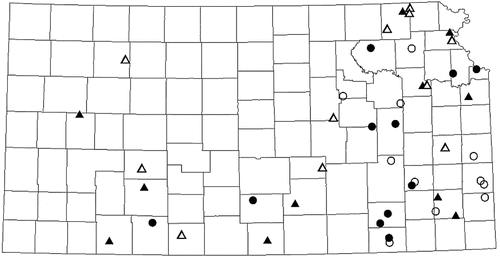
Preliminary analysis of the population of 102 lake/watershed units revealed that lake age was normally distributed but all other parameters required data transformation. For this portion of the analysis, only TP and Chl-a were included as water quality variables. Correlative relations among TP, Chl-a, and selected lake and watershed physical features (), and parameter mean values and other descriptive statistics for the four lake/watershed groups (, , , ) were determined.
Table 1 Pearson correlations (R) among physical and water quality features, utilizing the final candidate list of 102 lake/watershed units. Significant (P ⩽ 0.05) correlations are shaded. All data, except watershed land use (portion in cropland or urban land) and lake age, used Log10 transformations to achieve normality. Watershed land use composition used a square-root transformation, while lake age did not require transformation of the data.
Table 2a Descriptive statistics for lake/watershed group “Newer Artificial Lakes in Unimpacted Watersheds.” N = 11 lake/watershed units.
Table 2b Descriptive statistics for lake/watershed group “Newer Artificial Lakes in Impacted Watersheds.” N = 11 lake/watershed units.
Table 2c Descriptive statistics for lake/watershed group “Older Artificial Lakes in Unimpacted Watersheds.” N = 11 lake/watershed units.
Table 2d Descriptive statistics for lake/watershed group “Older Artificial Lakes in Impacted Watersheds.” N = 11 lake/watershed units.
Lake age revealed no significant correlations with any other factor except lake surface area. This weak but significant correlation (R =−0.247, P ⩽ 0.05) was expected based on improvements in earth moving technology following World Wars I and II, which enhanced the ability to build larger artificial lakes (CitationStene 1946). The percentage of cropland and urban land within watersheds was correlated significantly to both trophic state variables but only weakly correlated (R =−0.265, P ⩽ 0.05) to one physical feature, retention time.
Regarding the three lake morphometric features, lake surface area was not significantly correlated with any other feature, except mean depth, in a fairly weak positive relationship (R =+0.413, P ⩽ 0.05). Depth and retention time showed a moderate positive correlation with each other (R =+0.613, P ⩽ 0.05), as might be intuitively expected. Both retention time and mean depth exhibited moderate negative correlations with the water quality variables TP and Chl-a (). The strongest relationship among all the comparisons was between the two water quality parameters, TP and Chl-a, described by the equation:
Based on the strength of the statistical correlations, minor differences in morphometric features would not be expected to significantly affect the final results of inter-group comparisons, although the four study groups achieved statistical similarity for the majority of morphometric and general water quality parameters in pair-wise comparisons.
Except for lake age and watershed composition (the two test parameters used to create the four lake/watershed groups), there were very few significant differences in terms of physical features and general water chemistry between groups (). However, the first lake/watershed group (newer artificial lakes with unimpacted watersheds) was slightly deeper than two of the other three groups. Nonetheless, the significant differences in mean depth are 1 m or less (, , , ), and our preliminary correlational results suggest that this should not exert substantial influence on intergroup comparisons. Likewise, newer lakes in unimpacted drainages tended to be slightly less saline and had slightly lower alkalinity, but the differences between groups are small compared to statewide variability. Mean total alkalinity differed by only 26 mg·L−1 between groups (105.0–130.9 mg·L−1), while statewide values range from <20 mg·L−1 to >500 mg·L−1. Mean total dissolved solids varied by only 107 mg·L−1 between groups (141.5–248.2 mg·L−1), while statewide values range from <40 mg·L−1 to >12,000 mg·L−1. As stated previously, the lack of western candidates for the new lakes/unimpacted drainages group likely explains a significant portion of these differences in both depths and salinity.
Table 3 Kruskal-Wallace test results (H) for inter-group comparisons for lake/watershed physical features and general water chemistry parameters. NU = newer artificial lakes in unimpacted watersheds; NX = newer artificial lakes in impacted watersheds; OU = older artificial lakes in unimpacted watersheds; and OX = older artificial lakes in impacted watersheds. Shaded results indicate statistically significant differences between group pairs (P ⩽ 0.05).
Comparisons of water quality parameters related to trophic state () show consistent significant differences between groups with differing levels of watershed land use composition, regardless of lake age category. Only one group comparison (newer/unimpacted vs. older/unimpacted) showed a significant difference based on lake age, and for only blue-green algae cell counts. This group difference disappeared when blue-green algal biovolume was examined. Additionally, neither group had what might be considered excessively high cell counts ( and ); suggesting the difference based on cell count may be an artifact.
Table 4 Kruskal-Wallace test results (H) for inter-group comparisons for lake/watershed nutrient and trophic state parameters. NU = newer artificial lakes in unimpacted watersheds; NX = newer artificial lakes in impacted watersheds; OU = older artificial lakes in unimpacted watersheds; and OX = older artificial lakes in impacted watersheds. Shaded results indicate statistically significant differences between group pairs (P ⩽ 0.05).
The follow up analysis using 126 lake/watershed units to examine cropland and age influences on trophic classification, TP, and Chl-a (, , , , ) indicated an upward trend, for both TP and Chl-a, with increasing proportions of cultivation within watersheds. There was no discernable trend related to lake age for either TP or Chl-a.
Figure 2 Percentage of surveyed lakes with a period-of-record trophic state classification of mesotrophic (TSIChl-a < 50), lower eutrophic (TSIChl-a 50–54.9), eutrophic (TSIChl-a 55–59.9), upper eutrophic (TSIChl-a 60–63.9), or hypereutrophic (TSIChl-a ⩾ 64), versus the percent of watershed land under cultivation.
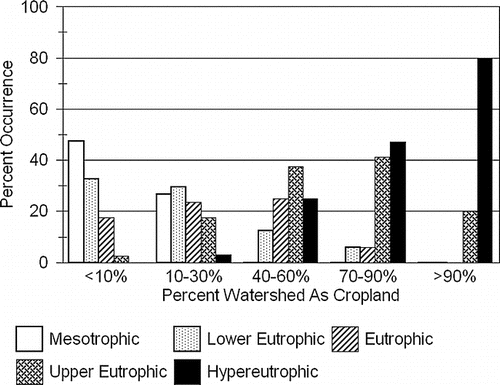
Figure 3 Box plots depicting period-of-record mean Carlson trophic state index (TSI) scores based on chlorophyll-a versus watershed classes based on the proportion of cropland in the drainage. Whiskers represent the maximum and minimum values, the central box the interquartile range and the median, and the black circle the mean. TSI-to-chlorophyll-a correspondences: 50 = 7.2 μg·L−1, 60 = 20.1 μg·L−1, 70 = 55.7 μg·L−1, and 80 = 154.3 μg·L−1.
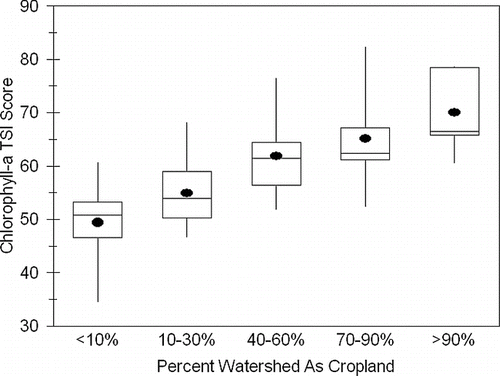
Figure 4 Box plots depicting period of record mean Carlson trophic state index (TSI) scores based on total phosphorus versus watershed classes based on the proportion of cropland in the drainage. Whiskers represent the maximum and minimum values, the central box the interquartile range and the median, and the black circle the mean. TSI-to-total phosphorus correspondences: 50 = 24 μg·L−1, 60 = 48 μg·L−1, 70 = 96 μg·L−1, and 80 = 192 μg·L−1.
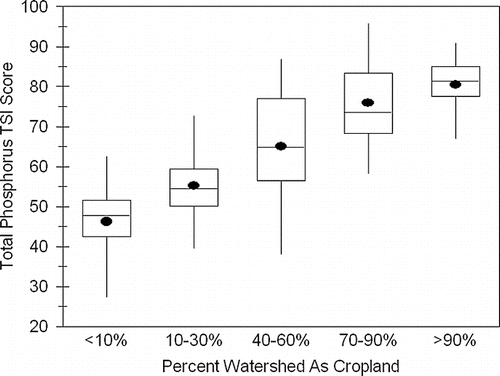
Figure 5 Box plots depicting period-of-record mean Carlson trophic state index (TSI) scores based on chlorophyll-a versus lake age classes based on the years since dam completion. Whiskers represent the maximum and minimum values, the central box the interquartile range and the median, and the black circle the mean. TSI-to-chlorophyll-a correspondences: 50 = 7.2 μg·L−1, 60 = 20.1 μg·L−1, 70 = 55.7 μg·L−1, and 80 = 154.3 μg·L−1.
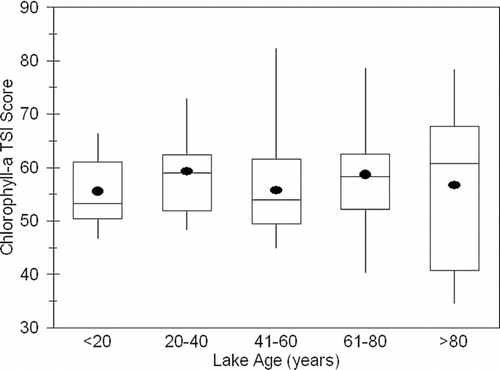
Figure 6 Box plots depicting period of record mean Carlson trophic state index (TSI) scores based on total phosphorus versus lake age classes based on the years since dam completion. Whiskers represent the maximum and minimum values, the central box the interquartile range and the median, and the black circle the mean. TSI-to-total phosphorus correspondences: 50 = 24 μg·L−1, 60 = 48 μg·L−1, 70 = 96 μg·L−1, and 80 = 192 μg·L−1.
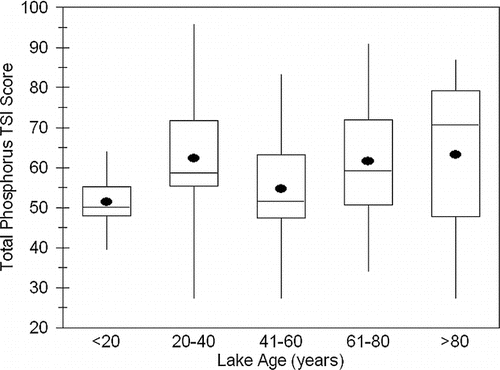
Discussion
Cultural eutrophication ultimately detracts from the beneficial uses derived from lakes, whether natural or artificial (CitationLund 1972, CitationUSEPA 1990, CitationCorrell 1998, CitationDaniel et al. 1998, CitationParry 1998, CitationSmith et al. 1999, CitationSmith 2003, CitationHatch 2008). Because use impairments lead to lost societal and ecological services, in addition to lost revenues that would be derived from those services, a great deal of effort has been expended to control nutrient pollution and curb eutrophication (CitationParry 1998). From a management perspective, however, eutrophication resulting from background nutrient loading in settings relatively unimpacted by human activities would not generally be deemed a problem requiring preventative or corrective actions. Rather, water quality and water resource managers would prefer to target controllable problems related specifically to human impacts.
Water resource managers should be able to demonstrate to the general public, preferably in a quantitative fashion, that preventative and remedial efforts adequately address the problems resulting from human activities, even if the baseline process contributing to the problems is a natural one (i.e., eutrophication). This quantitative analysis provides such a demonstration for artificial lakes in Kansas and the Midwest.
Specifically, paired lake/watershed group comparisons () and an analysis of state classification versus cropland development (–), illustrated the importance of watershed land use composition in determining lake water quality and trophic state condition. Artificial lakes with watersheds dominated by cropland and/or urban development generally exhibited a hypereutrophic condition (mean TSIChl-a > 64), irrespective of lake age. Conversely, lakes of any age in watersheds with little overt human activity (i.e., mostly grassed or wooded) generally were near the boundary between mesotrophic and eutrophic (mean TSIChl-a < 50), very near regional reference condition thresholds for water bodies in the Midwest (CitationDodds et al. 2006). The analysis of state classification versus cropland levels corroborates previous limnological studies in the Midwest (e.g., CitationJones et al. 2004).
Although eutrophication is a naturally occurring process, this analysis provides evidence of a tremendous difference between the natural process and its augmented form, cultural eutrophication, in artificial lakes of Kansas. These differences can be expressed as the time required for eutrophication to become evident to the typical observer or the magnitude of change that can be expected within an average human lifetime. In watersheds covered predominately by native vegetation, or at least a permanent grassland/wooded cover of some type, even artificial lakes should undergo slow eutrophication (CitationUSEPA 1990, Citation1993, CitationdeJonge et al. 2002, CitationDodds et al. 2006). Conversely, watersheds with abundant human activities that increase the export of nutrients will more rapidly produce elevated trophic states and degraded water quality in the receiving lake. Eutrophication as a natural process does not provide justification for avoiding the management of nutrients in runoff.
Acknowledgment
I thank Dr. Robert T. Angelo (KDHE) and Diana L. Chamberlain (KDHE) for review comments and suggestions, as well as the anonymous reviewers, for helping to improve this manuscript. In addition, thanks go to the numerous field technicians and ecologists with the KDHE Bureau of Environmental Field Services, past and present, who have collected many thousands of lake and wetland water quality samples, and the laboratory technicians at the Kansas Health and Environmental Laboratories, who have analyzed those samples over the last 33 years.
References
- APHA . 1989 . “ American Public Health Association-American Water Works Association-Water Pollution Control Federation ” . In Standard methods for the examination of water and wastewater , 17th Washington , D.C.
- Carlson , R. E. 1977 . A trophic state index for lakes . Limnol. Oceanogr. , 22 ( 2 ) : 361 – 369 .
- Correll , D. L. 1998 . The role of phosphorus in the eutrophication of receiving waters: a review . J. Environ. Qual. , 27 : 261 – 266 .
- Daniel , T. C. , Sharply , A. N. and Lemunyon , J. L. 1998 . Agricultural phosphorus and eutrophication: a symposium overview . J. Environ. Qual. , 27 : 251 – 257 .
- Dodds , W. K. , Carney , E. and Angelo , R. T. 2006 . Determining ecoregional reference conditions for nutrients, Secchi depth and chlorophyll-a in Kansas lakes and reservoirs . Lake Reserv. Manage. , 22 ( 2 ) : 151 – 159 .
- Hatch , L. K. 2008 . Lakes and angling . LakeLine , 28 ( 1 ) : 21 – 23 .
- Horne , A. J. and Goldman , C. R. 1994 . Limnology , 2nd , 576 New York : McGraw-Hill, Inc. .
- Jones , J. R. , Knowlton , M. F. , Obrecht , D. V. and Cook , E. A. 2004 . Importance of landscape variables and morphology on nutrients in Missouri reservoirs . Can. J. Fish. Aquat. Sci. , 61 : 503 – 512 .
- deJonge , V. N. , Elliott , M. and Orive , E. 2002 . Causes, historical development, effects and future challenges of a common environmental problem: eutrophication . Hydrobiologia , 475/476 : 1 – 19 .
- KDHE . 2005 . Division of Environment quality management plan, part III: lake and wetland water quality monitoring program quality assurance management plan , Kansas Department of Health and Environment .
- Lind , O. T. 1974 . Handbook of common methods in limnology , 154 MO : The C.V. Mosby Co., St. Louis .
- Lund , J. W.G. 1972 . Eutrophication . Proc. R. Soc. Lond. B. , 180 : 371 – 382 .
- Parry , R. 1998 . Agricultural phosphorus and water quality: a U.S. Environmental Protection Agency perspective . J. Environ. Qual. , 27 : 258 – 261 .
- Sheskin , D. J. 1997 . Handbook of parametric and nonparametric statistical procedures , 719 New York : CRC Press .
- Smith , V. H. 2003 . Eutrophication of freshwater and coastal marine ecosystems: a global problem . Environ. Sci. Pollut. Res. , 10 ( 1 ) : 1 – 14 .
- Smith , V. H. , Tillman , G. D. and Nekola , J. C. 1999 . Eutrophication: impacts of excess nutrient inputs on freshwater, marine, and terrestrial ecosystems . Environ. Pollut. , 100 : 179 – 196 .
- Stene , E. O. 1946 . How lakes came to Kansas . Trans. Kansas Acad. Sci. , 49 ( 2 ) : 117 – 137 .
- USEPA . 1990 . The lake and reservoir restoration guidance manual: second edition , 326 Washington , D.C. : Office of Water, United States Environmental Protection Agency . EPA-440/4-90-006
- USEPA . 1993 . Fish and fisheries management in lakes and reservoirs: technical supplement to the lake and reservoir restoration guidance manual , 321 Washington , D.C. : Water Division, United States Environmental Protection Agency . EPA-841-R-93-002
- Walker , W. W. 1986 . Empirical methods for predicting eutrophication in impoundments; report 4, phase III: applications manual , Vicksburg , MS : United States Army Engineer Waterways Experiment Station . Technical Report E-81-9
- Wetzel , R. G. 1983 . Limnology , 2nd , 767 New York : Saunders College Publishing .